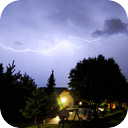(short preview of full seamless looping track)
Suburban ThunderStorm
This product is not available in the selected currency.
In Stock
Backordered
Out of Stock
Description
The quaint little neighborhood is shaken by the growing storm above. All of the residents retreat from the playgrounds and strip malls to find warmth and protection inside their homes. You watch through the window at the approaching strikes of lightning, hoping that they don't strike close to your house. Soon your tea is cold as you forget to sip, entranced by the bright flickers in the sky, and the thought of running to hide under your blankets overwhelms you. The word suburb mostly refers to a residential area, either existing as part of a city (as in Australia and New Zealand) or as a separate residential community within commuting distance of a city (as in the United States and Canada). Suburbs first emerged on a large scale in the 19th and 20th century as a result of improved rail and road transport, leading to an increase in commuting. Suburbs tend to proliferate around cities that have an abundance of adjacent flat land. Any particular suburban area is referred to as a suburb, while suburban areas on the whole are referred to as the suburbs or suburbia, with the demonym for a suburb-dweller being suburbanite. Colloquial usage sometimes shortens the term to burb. The word is derived from the Old French subburbe, which is in turn derived from the Latin suburbium, formed from sub (meaning "under") and urbs ("city"). In Ancient Rome, wealthy and important people tended to live on the hills of the city, while poorer citizens lived at lower elevations – hence "under the city". The first recorded usage of the term in English, according to the Oxford English Dictionary, was made by John Wycliffe in 1380, where the form subarbis was used.
Opps
Sorry, it looks like some products are not available in selected quantity.



